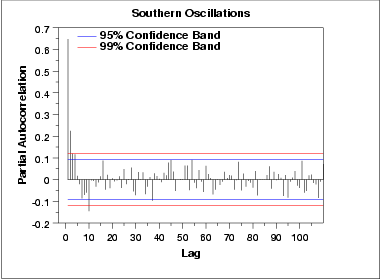6.4. Introduction to Time Series Analysis
6.4.4. Univariate Time Series Models
6.4.4.6. Box-Jenkins Model Identification
6.4.4.6.3. |
Partial Autocorrelation Plot |
The partial autocorrelation at lag \(k\) is the autocorrelation between \(X_t\) and \(X_{t-k}\) that is not accounted for by lags 1 through \(k-1\).
There are algorithms, not discussed here, for computing the partial autocorrelation based on the sample autocorrelations. See (Box, Jenkins, and Reinsel 1970) or (Brockwell, 1991) for the mathematical details.
Specifically, partial autocorrelations are useful in identifying the order of an autoregressive model. The partial autocorrelation of an AR(\(p\)) process is zero at lag \(p+1\) and greater. If the sample autocorrelation plot indicates that an AR model may be appropriate, then the sample partial autocorrelation plot is examined to help identify the order. We look for the point on the plot where the partial autocorrelations essentially become zero. Placing a 95 % confidence interval for statistical significance is helpful for this purpose.
The approximate 95 % confidence interval for the partial autocorrelations are at \(\pm 2/\sqrt{N}\).

This partial autocorrelation plot, for the southern oscillations data set, shows clear statistical significance for lags 1 and 2 (lag 0 is always 1). The next few lags are at the borderline of statistical significance. If the autocorrelation plot indicates that an AR model is appropriate, we could start our modeling with an AR(2) model. We might compare this with an AR(3) model.
| Vertical axis: | Partial autocorrelation coefficient at lag \(h\). |
| Horizontal axis: | Time lag \(h \, (h=0, \, 1, \, 2, \, 3, \, \ldots)\). |
- Is an AR model appropriate for the data?
- If an AR model is appropriate, what order should we use?
Run Sequence Plot
Spectral Plot

